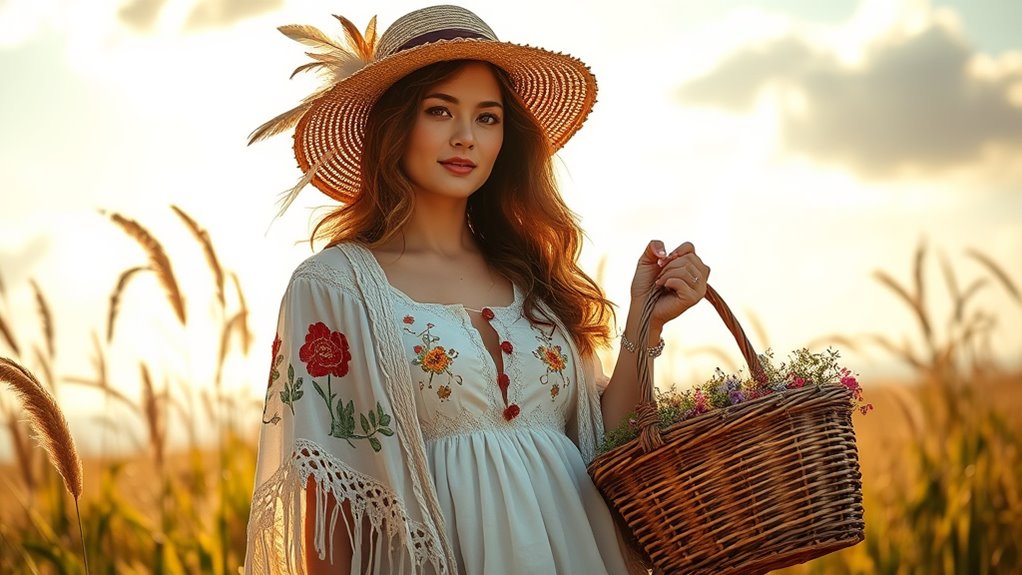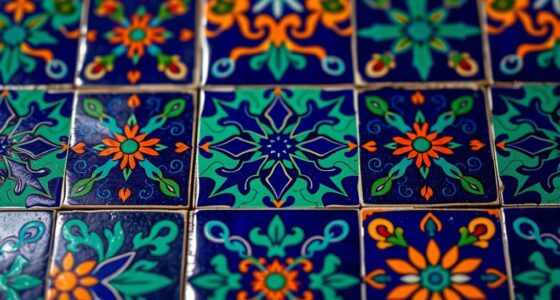Haute bohémien, or early 20th-century Boho Chic, reflects a style rooted in authenticity, craftsmanship, and cultural diversity. It emerged among artists and creatives who rejected traditional fashion norms, embracing vintage textiles, handmade details, and eclectic influences from around the world. This look celebrates individuality and history, blending folk motifs, Native American patterns, and global textures. If you want to explore how this unique style evolved and continues to influence modern fashion, there’s more to discover beyond the surface.
Key Takeaways
- Haute Bohémien emerged from artists seeking authentic, individualized fashion using vintage textiles and artisanal craftsmanship.
- It combined diverse cultural influences, like Eastern textiles and Native American patterns, creating a rich, eclectic style.
- Handcrafted details, embroidery, and fabric repurposing emphasized authenticity and a connection to history.
- Vintage textiles served as nostalgia and rebellion, layered for personalized, expressive outfits reflecting cultural diversity.
- The style laid the foundation for timeless, creative fashion emphasizing quality, individuality, and global cultural appreciation.

Have you ever wondered how the boho chic style first took shape in the early 20th century? It’s a story rooted in a desire for authenticity, individuality, and a break from the rigid fashion norms of the past. During this time, a movement emerged among artists, writers, and creatives who sought to express their free spirit through clothing that reflected their lives and beliefs. They turned to vintage textiles, repurposing fabrics from different eras, which allowed them to create unique, layered looks full of history and character. These vintage textiles weren’t just about nostalgia; they embodied a sense of connection to the past and a rebellion against mass-produced fashion. Each piece carried its own story, and by mixing these textiles, you could craft an outfit that was as much a statement of personality as it was a reflection of cultural influences.
Artisanal craftsmanship played a *pivotal* role in shaping early boho style. Instead of relying on factory-made garments, enthusiasts and artisans emphasized handmade details, embroidery, and intricate embellishments. This focus on artisanal craftsmanship meant that each piece was unique, often customized, and imbued with a sense of care and tradition. You might find yourself wearing a hand-stitched blouse, a fringed shawl, or jewelry crafted by local artisans, all of which added to the eclectic, personalized vibe of the boho aesthetic. This approach was about more than just fashion; it was a statement of values, emphasizing quality, authenticity, and a connection to traditional crafts that had been passed down through generations.
The early boho chic movement also drew inspiration from various cultural influences, blending Eastern textiles, Native American patterns, and folk motifs. This melding of styles created a rich tapestry of visual interest, emphasizing diversity and global connection. You could combine a vintage embroidered skirt with a fringed leather bag and layered beaded necklaces, capturing the essence of this eclectic style. It wasn’t simply about wearing pretty clothes; it was about a lifestyle that celebrated creativity, freedom, and a respect for craftsmanship. The use of vintage textiles and artisanal craftsmanship gave boho its depth and timeless appeal, setting the foundation for a style that continues to inspire today’s fashion scene.
Frequently Asked Questions
How Did Haute Bohémien Influence Modern Boho Fashion?
You can see how Haute Bohémien influences modern boho fashion through its embrace of Art Nouveau’s free-flowing lines and Art Deco’s geometric patterns. It encourages you to mix vintage textiles, layered jewelry, and eclectic styles, creating a look that’s both artistic and relaxed. This early 20th-century trend inspires your unique style, blending historical elegance with contemporary comfort, making boho fashion rich with creative freedom and timeless appeal.
What Materials Were Commonly Used in Early 20th-Century Boho Clothing?
Imagine wandering through a market stall, where cotton, silk, and wool fabrics beckon. In early 20th-century boho clothing, you’d find materials like linen and velvet, often decorated with intricate textile techniques like embroidery and patchwork. Accessories featured natural elements—feathers, beads, and leather—adding rustic charm. These materials and styles created a free-spirited look that still influences your modern boho wardrobe today.
Who Were Prominent Designers Shaping the Haute Bohémien Style?
You see that Art Nouveau influence and Flapper Fashion defined the designers shaping the haute bohémien style. Designers like Paul Poiret and Coco Chanel pioneered this look, blending flowing fabrics and intricate patterns inspired by Art Nouveau. They embraced the rebellious spirit of Flapper Fashion, with fringe, beaded dresses, and bold accessories, creating a free-spirited, eclectic aesthetic that became iconic in early 20th-century boho chic.
How Did Cultural Exchanges Impact Boho Aesthetics During This Period?
You might think cultural exchange was just a fancy term, but really, it fueled boho aesthetics with vibrant fusion. Artistic collaborations brought diverse influences like Eastern textiles and African patterns into the mix, creating a colorful tapestry. These cross-cultural sparks turned simple fashion into a bold statement of global unity, proving that a little cultural fusion can transform ordinary fabric into extraordinary art—an ironic celebration of diversity through style.
Social movements played a pivotal role in popularizing haute bohémien by fueling fashion evolution and inspiring individual expression. As you embrace this style, you participate in a broader trend driven by social activism, which challenged traditional norms and promoted freedom, diversity, and creativity. This movement encouraged you to mix unconventional fabrics, patterns, and accessories, making haute bohémien a symbol of rebellion, unity, and cultural exchange during the early 20th century.
Conclusion
Remember, fashion is a reflection of your spirit. Embracing the haute bohémien style shows that you value freedom, creativity, and individuality—just like the early 20th-century boho chic. By blending vintage influences with a carefree attitude, you honor a timeless tradition of self-expression. As the saying goes, “Fashion fades, but style is eternal.” So, wear your unique story proudly, and let your style speak louder than words.










